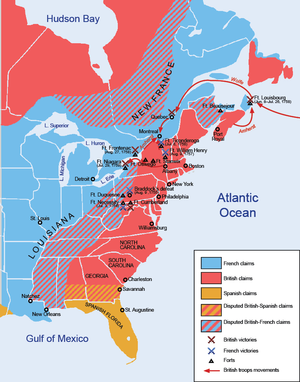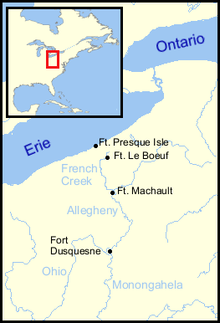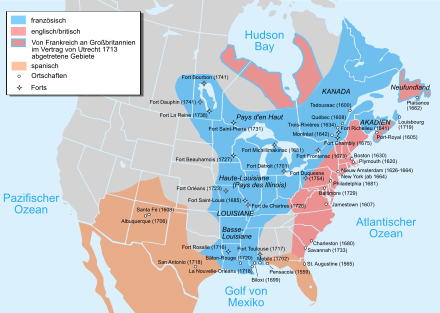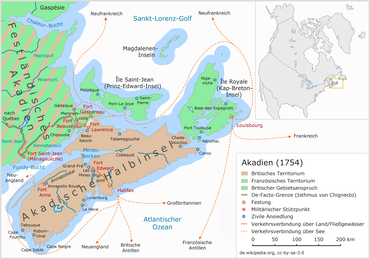French and Indian War
French and Indian War
Part of: Seven Years' War

Seven Years' War (1756-1763)
European theater of war:
Pirna* - Lobositz* - Prague* - Kolin* - Hastenbeck** - Groß-Jägersdorf* - Moys* - Hastenbeck* - Roßbach* - Breslau* - Leuthen* - Rheinberg** - Krefeld** - Domstadtl* - Olmütz* - Mehr** - Zorndorf* - Saint-Cast - Hochkirch* - Bergen** - Kay* - Minden** - Kunersdorf* - Lagos*** - Hoyerswerda* - Bay of Quiberon*** - Maxen* - Koßdorf* - Landeshut* - Emsdorf** - Warburg** - Liegnitz* - Berlin* - Kloster Kampen** - Torgau* - Döbeln* - Vellinghausen** - Ölper** - Burkersdorf* - Reichenbach* - Freiberg*
(* Third Silesian War, ** Western theatre of war - Great Britain/Kur-Hannover a. o. Allies against France, *** Naval battle)
American theater of war:
Seven Years' War in North America
Monongahela - Carillon - La Belle Famille - Québec - Beauport - Abraham Plain - Sainte-Foy - Restigouche
Asian theater of war:
Third Carnatic War
Cuddalore - Negapatam - Pondicherry - Wandiwash - Manila
In the Seven Years' War in North America (French and Indian War; French Guerre de la Conquête), the colonial powers of Great Britain and France, supported by their respective Indian allies, fought for supremacy in North America from 1754 to 1763. The main theater was the British East Coast colonies and New France around the St. Lawrence River (roughly present-day Quebec). The conflict was a sub-conflict of the Seven Years' War, the beginning of which historiography generally places at the onset of hostilities in Europe and the formal declarations of war by the European powers involved in 1756. The Peace of Paris of 1763 sealed the end of French colonial rule in North America east of the Mississippi. The war was therefore of great importance for the history of Canada but also for the emergence of the USA.
Origin
The Seven Years' War in North America was the fourth in a series of colonial wars fought overseas by the two great European powers, France and England (or Britain), collectively known as the French and Indian Wars. Each of these wars had its counterpart in European wars: King William's War (1689-97) was part of the Palatinate War of Succession, Queen Anne's War (1702-1713) that of the Spanish War of Succession, and King George's War (1744-1748) that of the Austrian War of Succession. Whereas these previous wars between the colonists of New England and New France were in a sense proxy wars triggered by dynastic disputes among the major European powers, the Seven Years' War began with a territorial conflict in North America itself.
The conflict over the Ohio Valley
Until the early 18th century, the area west of the Appalachians had remained largely untouched by European settlers. This changed around 1750, when adventurers from the British colonies of Pennsylvania and Virginia increasingly ventured into the Ohio territory to trade with the Indians there. The fertile lands beyond the Appalachians also aroused the desires of land speculators. Thus, as early as 1745, the House of Burgesses, the lower house of Virginia, granted settlement patents over extensive lands in the Ohio Valley to the Ohio Company, a corporation of land speculators. Robert Dinwiddie, Virginia's deputy governor from 1751, also held shares in this company, which also makes his efforts to gain English dominion in the Ohio territory seem thoroughly self-serving.
However, the sovereign claims of the British colonies clashed with those of France, which claimed all of North America beyond the Appalachian watershed as part of New France. The Ohio Valley was of particular strategic importance to France, as it provided an almost continuous navigable link between the French settlements on the Saint Lawrence River and the Great Lakes and those on the middle and lower reaches of the Mississippi.
To bolster their claims, in 1749 the French equipped an expedition led by Pierre Joseph Céloron de Blainville (1693-1759), who conducted surveys and exhorted the Indian tribes of the area to expel any British traders from the Ohio Valley. To press this demand, a force of Chippewa and Ottawa Indians, traditional allies of the French, destroyed the village of Pickawillany, the top-selling English trading post in the region.
The Ohio Company, however, continued its efforts undeterred, first building Fort Cumberland in 1749, just a few miles east of the ridge, as a fortified storehouse and starting point for western trade, then another fort at the headwaters of the Monongahela River, one of the Ohio's headwaters. In 1752, Michel-Ange Duquesne de Menneville (1700-1778) arrived in Quebec as the new governor of New France with the unmistakable order to drive the British out of the Ohio Valley. He therefore ordered the erection of a chain of four forts between Lake Erie and the Ohio. The southernmost fort, named Fort Duquesne after himself, was to be built at the point where the Monongahela and the Allegheny join the Ohio. At that very spot, the Ohio Company began construction of its own fort in February 1754, making direct military confrontation inevitable.
The third power factor in the Ohio region were the Indian tribes residing in this area: For several decades, groups of Shawnees and Delawares settled here, who in turn had previously been subjugated by the Iroquois League in the north. The Iroquois exercised their rule in the region through so-called "half-kings," Iroquois emissaries who presided over the settlements of the subjugated tribes. As the conflict between the two colonial powers intensified, these tribes hoped to ally with France and free themselves from Iroquois rule.
The conflict over Acadia
Another source of conflict was the Canadian province of Acadia, which comprised all or part of the present-day provinces of Nova Scotia, New Brunswick and Quebec. This territory had been conquered by British forces in 1710 during the War of the Spanish Succession (1701-1714) and transferred to Great Britain at the Peace of Utrecht in 1713. The French-born, Catholic population nevertheless enjoyed extensive autonomy and religious freedom; British garrisons were located only in Annapolis Royal and in Halifax, founded in 1749, around which a British settlement core developed.
France, however, was not resigned to this loss. French priests, missionaries, and officers tried openly or covertly to incite the Acadians to revolt against the British, to recruit them into the French military, or to induce them to emigrate to French-controlled territories. Abbé Jean-Louis Le Loutre (1709-1772), Catholic vicar general of Acadia and missionary to the Micmacs, a Native American tribe living there, played a key role in this. He required the Acadians to refuse the oath of allegiance to the British king and to emigrate. The Indians under his influence put pressure on the Acadians and started a small war against the British: At his instigation, attacks were made on British traders, soldiers, and settlements. French documents show that the clergyman paid the Indians 100 livres for each scalp of a Briton. Beginning in 1750, there were repeated violent attacks involving Acadians as well as Indians. After the French established Fort Beauséjour on territory claimed by Britain in 1751 and required Acadians to take an oath of allegiance to the King of France, serve in the French militia, or be treated as rebels, the open outbreak of hostilities was only a matter of time here as well. In 1754, the British governor of Acadia responded with a proclamation that any Acadians who took the oath of allegiance but took up arms against the British would be treated as criminals.
The road to war
In 1750, at a meeting in Paris, British and French envoys tried unsuccessfully to resolve the Ohio Valley and Acadian problems. In 1752 Michel-Ange Duquesne de Menneville, the Marquis de Duquesne, was made governor-general of New France (Canada) and given the explicit task of securing the Ohio Valley for France and driving the British out of the area. The following year he sent troops to lay fortifications at Presque Island (near Erie, Pennsylvania) and at Rivière aux Boeufs (near Waterford). French officers and missionaries began systematic efforts to push back the influence of British traders on the Indians and bring them over to their side. Due in no small part to the inaction of the British, the French were able to win over most of the tribes. At the same time, British settlers and traders from Virginia, encouraged by their governor Robert Dinwiddie, increasingly pushed into the Ohio Valley, which Dinwiddie claimed as part of his colony.
The French were clearly at a disadvantage due to the numerically smaller population of their colony (about 60,000 against more than 2 million in British North America). In this respect, their chances of a successful outcome to the war were very poor from the outset. It is true that the warfare of the British was hampered by the lack of a coordinating authority above the individual colonies, here above all by the internal conflicts between the governors and the parliaments of the colonies, which led to the urgently needed funds for the construction of forts, for gifts to the Indians and for the salaries of troops not being granted. In like manner, however, the defenses of New France were strained by the conflict between Governor Vaudreuil and General Montcalm and the endemic corruption in the colonies.

French forts in the years 1753 and 1754

North America, around 1750, with dates of the foundations
Outbreak of war
After learning of new forts being built by the French on the upper Allegheny River, Dinwiddie sent a young Virginia officer, George Washington, with a written request for the French to leave the region, which was unsuccessful. On his way back, Washington determined that the spot where the Allegheny and Monongahela Rivers converged to form the Ohio was an excellent site for a fort. Early in 1754, therefore, the British began construction of Fort Prince George. The French, however, learned of it, sent military, forced the British to withdraw without a fight on April 17, destroyed the fortification, and built a larger one in its place, which they named Fort Duquesne after their governor.
Washington, meanwhile, had been sent west with some soldiers to secure the British positions there, and was staying in the Great Meadows (near present-day Uniontown, Pennsylvania), located near Fort Duquesne. When he learned that there were French soldiers near his camp, he attacked them on May 29, wanting to forestall an ambush.
With this skirmish, which was successful for the British, the so-called Jumonville Incident (after a French officer killed in it), the war broke out openly. Upon news of the raid, the commander of Fort Duquesne sent in vastly outnumbered reinforcements, which trapped Washington and his men in the hastily constructed Fort Necessity and, after a brief engagement, forced them to surrender on July 3 in exchange for free passage. With this incident, war had become inevitable.
The following year, Major General Edward Braddock was sent to America and appointed British commander-in-chief. A French fleet then sailed for Canada with troops under the German-born General Baron Jean-Armand de Dieskau (1701-1767). A British squadron under Vice-Admiral Edward Boscawen tried unsuccessfully to intercept the French, but was able to engage three French ships of the line on 6 June and, after a brief engagement, forced two of them, the Alcide and the Lys, which was serving as a troop transport, to surrender.
Meanwhile the British had decided on the execution of four simultaneous attacks on the French. One expedition, formed mostly of regular troops under Braddock, was to attack Fort Duquesne, a second of militia troops under Sir William Johnson was directed against the fort at Crown Point, and a third army, also formed of militia troops, was to drive the French from Acadia. In a fourth effort, troops under William Shirley, governor of Massachusetts, were to attack Fort Niagara.
In April 1755 Braddock began his march on Fort Duquesne with about 2,200 men, but was crushed and mortally wounded by the French and their Indian allies at the Battle of Monongahela on July 9. The British attack on the Ohio Valley was thus repulsed, but they were more successful in the north. The militiamen under Johnson were able to lay out the strategically important fortification of Fort Edward (Fort Lyman) on the Hudson River and defeat the Dieskau-led French at the Battle of Lake George on September 8, 1755. Johnson did lay out Fort William Henry on Lake George, also strategically important, but passed up the opportunity to attack Crown Point.
Shirley's advance on Fort Niagara was also unsuccessful. The British marched as far as Lake Ontario, but confined themselves to reinforcing Fort Oswego. This was due to supply difficulties and French troops at Fort Frontenac, which would have cut off lines of communication if Fort Niagara had been attacked.
Successful, however, was an expedition of New England militia and regular soldiers from the Halifax garrison under Brigadier General Robert Monckton. This force landed at British Fort Lawrence in early June and shortly thereafter began a siege of nearby French Fort Beauséjour. After a two-week siege, the French defenders surrendered on June 16. With this, the British troops succeeded in a decisive break-in into the French defence system and the strategically so extremely important French sea fortress Louisbourg was isolated from any hinterland since this defeat. At the same time, the French settlers of Acadia were cut off from any support from the Canadian heartland.
After the Acadians refused further calls to take the oath of allegiance to the British crown, the British began arresting and deporting the entire French-born population of Acadia on September 5, unless they evaded it by fleeing. Beginning on October 8, over 6,000 men, women, and children were shipped to the British colonies in New England. With this harsh - and even for the time exceptionally cruel - measure, the British position in Acadia was secured. A small force of French troops thereafter engaged the British in small-scale warfare in the woods for several years, but the French were unable to make a serious attempt at reconquest.
In addition to these larger military operations, 1755 also saw the beginning of a savage small-scale war on the borders of the British colonies, whose main victims were the largely defenseless settlers. Indians supported by French soldiers made numerous advances - not least on the road built by Braddock's soldiers - particularly into Pennsylvania, Maryland and Virginia, destroying settlements and farms and killing or abducting their inhabitants. These attacks were facilitated by the fact that the Pennsylvania legislature, dominated by pacifist Quakers, refused to approve defensive measures and provide funds for an extended period of time due to constitutional disputes with the governor. As a result, the Abenaki from what is now the Canadian province of Quebéc alone are said to have killed more than 600 British. They, in turn, retaliated with brutal revenge campaigns against Indians and - as far as tangible - French settlements. Soldiers under the command of Major Robert Rogers attacked the main settlement of the Abenakis in September 1759 and carried out a massacre there, which allegedly claimed the lives of about 200 Indians. These figures, however, do not stand up to close scrutiny; in reality, the number of victims was probably far lower. In internal French communications, for example, there is talk of 30 dead. For propagandistic reasons - and to justify Roger's own high losses - a higher number was reported.

Acadia (1754)
Questions and Answers
Q: What was the French and Indian War?
A: The French and Indian War was a conflict fought between 1754 and 1763 in British North America and French North America over land that is now part of the United States and Canada.
Q: Who were the combatants in this war?
A: The combatants in this war were France, Britain, Native American allies of France, and other allies of Britain.
Q: When did it take place?
A: The French and Indian War took place between 1754-1763.
Q: Where did it take place?
A: The conflict took place in British North America and French North America, which are now parts of the United States and Canada.
Q: How was it related to the Seven Years' War?
A: The French and Indian War was a part of the larger Seven Years' War among European great powers that occurred in various parts of the world.
Q: Why didn't France send many troops to Canada during this time period?
A: During this time period, France was already fighting Prussia so they could not send many troops to Canada for support.
Search within the encyclopedia